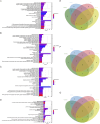Estrogen: the forgotten player in metaflammation
- PMID: 39575382
- PMCID: PMC11578702
- DOI: 10.3389/fphar.2024.1478819
Estrogen: the forgotten player in metaflammation
Abstract
Metaflammation is low-grade inflammation triggered by chronic metabolic imbalance and caused by dysregulated metabolites in metabolic inflammatory syndrome (MIS), which includes four diseases: obesity, type 2 diabetes mellitus (T2DM), atherosclerosis (AS), and nonalcoholic fatty liver diseases (NAFLD, recently proposed to be replaced by metabolic dysfunction-associated steatotic liver disease, MASLD). These diseases exhibit apparent sex dimorphism as regards MIS. Estrogen not only plays a crucial role in gender differences in adults but also possesses an anti-inflammatory effect on many metabolic diseases. In this study, we present a prediction of the differential proteins and signal transduction of estrogen in MIS through network pharmacology and review the validated studies on obesity, T2DM, AS, and NAFLD. Subsequently, we compared them to obtain valuable targets, identify current gaps, and provide perspectives for future research on the mechanisms of estrogen in metaflammation.
Keywords: antiinflammatory effects; estrogen; hormone replacement therapy (HRT); metabolic inflammatory syndrome; metaflammation; network pharmacology; pharmacological targets; sex differences.
Copyright © 2024 Zhu, Liao, Tian, Yu, Xie, Sun, Zhou, Han, Zhao, El-Kassas, Liu, Sun and Zhang.
Conflict of interest statement
The authors declare that the research was conducted in the absence of any commercial or financial relationships that could be construed as a potential conflict of interest.
Figures





Similar articles
-
Type 2 diabetes mellitus and cardiometabolic outcomes in metabolic dysfunction-associated steatotic liver disease population.Diabetes Res Clin Pract. 2024 May;211:111652. doi: 10.1016/j.diabres.2024.111652. Epub 2024 Apr 2. Diabetes Res Clin Pract. 2024. PMID: 38574897 Review.
-
Association of Metabolic Dysfunction-Associated Steatotic Liver Disease/Non-alcoholic Fatty Liver Disease With Type 2 Diabetes Mellitus: A Case-Control Study in a Tertiary Care Hospital in Pakistan.Cureus. 2023 Oct 17;15(10):e47240. doi: 10.7759/cureus.47240. eCollection 2023 Oct. Cureus. 2023. PMID: 38021965 Free PMC article.
-
Molecular mechanism of Fufang Zhenzhu Tiaozhi capsule in the treatment of type 2 diabetes mellitus with nonalcoholic fatty liver disease based on network pharmacology and validation in minipigs.J Ethnopharmacol. 2021 Jun 28;274:114056. doi: 10.1016/j.jep.2021.114056. Epub 2021 Mar 23. J Ethnopharmacol. 2021. PMID: 33771638
-
Regulating metabolic inflammation by nutritional modulation.J Allergy Clin Immunol. 2020 Oct;146(4):706-720. doi: 10.1016/j.jaci.2020.08.013. Epub 2020 Aug 22. J Allergy Clin Immunol. 2020. PMID: 32841652
-
Pharmacological therapy of metabolic dysfunction-associated steatotic liver disease-driven hepatocellular carcinoma.Front Pharmacol. 2024 Jan 19;14:1336216. doi: 10.3389/fphar.2023.1336216. eCollection 2023. Front Pharmacol. 2024. PMID: 38313077 Free PMC article. Review.
Cited by
-
High-Fat Diet and Metabolic Diseases: A Comparative Analysis of Sex-Dependent Responses and Mechanisms.Int J Mol Sci. 2025 May 16;26(10):4777. doi: 10.3390/ijms26104777. Int J Mol Sci. 2025. PMID: 40429918 Free PMC article. Review.
-
Gender differences in the association between weight-adjusted waist index and migraine: A cross-sectional study.PLoS One. 2025 May 16;20(5):e0323087. doi: 10.1371/journal.pone.0323087. eCollection 2025. PLoS One. 2025. PMID: 40378149 Free PMC article.
-
The Use of MSCs, iPSCs, and EVs in the Repair of Human MSK Tissues: Is Ultimate Success Dependent on Developing Excellent Implant Materials as Well as Creating an Optimal Environment for Implantation? What Is the Rationale for These Choices?Int J Mol Sci. 2025 Jun 28;26(13):6250. doi: 10.3390/ijms26136250. Int J Mol Sci. 2025. PMID: 40650028 Free PMC article. Review.
References
Publication types
LinkOut - more resources
Full Text Sources
Research Materials

